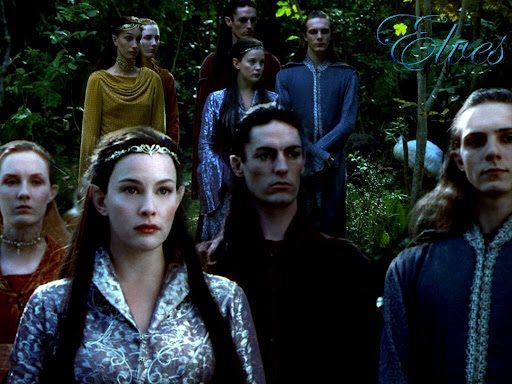
Further minor Norse elements appear within this general culture. The concept of wergild, for example, is represented in T'urin's response to the accidental slaying of M'im the dwarf's son. "'I will pay you a danwedh of heavy gold for your son, in token of sorrow, even if it gladdens your heart no more,'" says T'urin to the bereaved dwarf. (H'urin, 132) And M'im, like Hreidmar, is satisfied with this payment.
Scenes of flyting, the ritual of insulting an opponent, aggravating him into a fury before battle, speckle the Eddas and sagas of the Old Norse. The dark, cruel humor of men about to kill each other is a trademark of Norse literature. The V"olsungasaga lacks extended scenes of flyting, but a prototype of the story in verse form found in the Elder Edda contains moments of flyting at its best (featuring Sinfjotli the berserker).Saeros' provocationis similar to the idea of flyting: Saeros, out of hatred for T'urin, heaps racial insults on him, mocks his appearance, and speaks contemptuously of the women of T'urin's people, angering T'urin into drawing his sword against him. This flyting, although the dialogue is one-sided, leads - like most flyting - to the mocker's humiliation and death.
He does so mainly through the influence of the Elves. They represent refinement, wisdom, artistry, and gentleness, and the difference Tolkien points out by contrasting the Easterlings with the House of Hador is that H'urin's people have had contact with Elves. All the great Men of Middle-Earth have contact with Elves in their formative years, including Beren, Aragron, H'urin, and T'urin, who was raised by Elves in Doriath; the Easterlings are an example of Men left to their own devices. Marjorie Burns, in her book Perilous Realms: Celtic and Norse in Tolkien's Middle-Earth, draws a connection between the Elves and the Celtic tradition, and from there links them to femininity and to Christianity; indeed, the effect that Elves have on Men is one of "Christianizing" them. The Children of H'urin stands out among other tales of the First Age as one dominated by Men, but the domestication of the Elves is still present, primarily through Beleg. Beleg comes after T'urin and enters the company of the outcasts, criminals, and vagabonds - Men much like the Easterlings, lawless, leaderless, and corrupt - and he gives them lembas, the life-giving bread of the Elves that is much like the bread of Communion, he tends their wounded, and he softens T'urin's proud, hard heart. With Beleg, T'urin leads his band of outlaws in battle against Morgoth's forces, turning them from selfish, ignoble behavior, robbing their own kind, to fight evil and protect their own kind.
Many arguments have been made for the prominence of women in Scandinavian literature and its implications for the role of women in Old Norse society. While calling the Vikings the first feminists may be exaggeration, it is undisputable that the female figure in the Norse world played a more active role than in parallel historical cultures. In the V"olsungasaga, Brynhild the Valkyrie, the warrior-woman whom Sigurd first finds clad in armor, is the driving force of the second section of the story, and Gudrun is the dominant character of the final chapters. In fact, the conniving and magical Grimhild, the fierce jealousy between Brynhild and Gudrun, and the ruthlessness of Signy as a mother make the women of the V"olsungasaga both stronger and more compelling than their male counterparts.
Tolkien is notorious for including few or no women in his tales – there is no mention of a female character anywhere in The Hobbit, and of the five women given any space in The Lord of the Rings (including Ioreth, the bustling healer), only one – Eowyn – plays a part in the main events. But in The Children of Hurin, female characters abound. Finduilas, Morwen, and Nienor play lead roles, but there are others, including Nellas, Melian, and Aerin, the abused wife of Brodda the Easterling. They do not have the same dramatic power as the women in the Volsungasaga – there is no Eowyn, no Valkyrie, no idealized Viking-woman here – and yet their presence is keen and their effects on the male figures of the story are apparent. Melian seems wiser than Thingol on every occasion, Nellas’ testimony redeems Turin, and Turin’s complex relationship with every woman he encounters, hinging on his childhood losses of both mother and beloved, infant sister, is a key element in his psychological makeup.
Labels: druid gods and goddesses all of the gods and goddesses list of all greek gods and goddesses celtic gods and goddesses black magic rituals book protection spell wicca wiccan book of shadows yule log